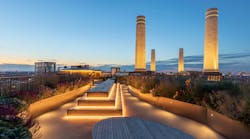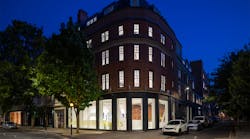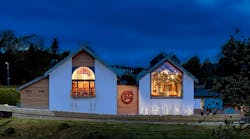The Challenge
The architecture of David Adjaye and his international firm Adjaye Associates is at once sculptural, textural, dynamic, and democratic. In Florida, the firm’s recent design for Winter Park Library & Events Center comprises three permanent pavilion structures sited on the northwest corner of Martin Luther King, Jr. Park.
Designed with biophilic principles in mind, the arches and the architecture at large draw inspiration from the local fauna and regional vernacular—think Spanish Revival loggias—while admitting natural light deeply into the building, explains Adjaye on his firm’s website.
The open porte cochère pavilion links the remaining two pavilions, which house a two-story library and an events center; the latter two structures are enclosed. Clad in distinctive rose-pigmented concrete, the pavilions cant outward as they rise, with arched cut-outs at their base. At the library and events pavilions, these openings are glazed and overlook Lake Mendsen to the southeast.
Inside the library pavilion, visitors traverse among stacks, reading areas, makerspaces, youth spaces, and a community room, while the events pavilion houses set-up space, a kitchen, an auditorium, and a rooftop venue. The moody interior finishes—purple and rust colors and textured surfaces—echo the exterior. A blackened steel spiral staircase in both the library and events center provides a dramatic and memorable focal point.
Lighting these unique building forms was more about the architecture and less about the fixtures, according to Erin Dreyfous, partner at Tillotson Design Associates, which led the project’s preliminary lighting design before handing it off to a local team for the construction documents and administration phases. She spoke with Architectural SSL on her team’s nuanced approach to balancing the abundance of daylight inside the structures with lighting their textured exteriors and the tropical climate.
How did you approach lighting the exteriors of these distinct architectural forms?
For us, it was thinking about the context and how the area is low-level residential. We wanted the center to feel like the heart of the community while providing sensitive nighttime lighting that complements the surroundings, versus being something that felt too commercial.
We completed many different studies in terms of composition; where we landed was featuring the main library pavilion while the event pavilion was secondary, establishing a hierarchy. We wanted the exterior to feel safe, with adequate lighting levels, but we kept the fixture types neutral—they don’t become these additional objects. We wanted the experience to be about the façade and the beautiful materials of these pavilions.
And how about lighting the textured exterior surfaces?
It’s always a conversation we have with the design team or architect early on when we are starting to establish project goals. For this project, we wanted to draw people in and make the center a lantern or beacon for the community, and we wanted to wash these exteriors in some way. There is a lot of back and forth. We do mock-ups in-house; and, in this case, the exterior has texture that will pick up light in a beautiful way.
We came up with a beautiful pairing where [the concrete] is a material that wants to be lit. Then, it was how best to do that considering the optics and the lensing of our fixtures. We laid out the lighting to have a bit more brightness or emphasis at the peaks of pavilion corners and then feathers out from there.
How did Florida’s tropical conditions affect the specifications?
The humidity and the weatherproofing were certainly [considerations]. Everything that we specified features IP68 sealed, marine-grade materials suited for that context and environment.
How did your minimal approach translate to the interior?
We pared it down to a utilitarian kit of parts. The library pavilion has a beautiful barrel-vaulted ceiling. We completed several studies to see what felt right there; we considered uplighting the barrels, but the architect wanted to keep it more austere and solid. We ended up combining linear sources with accent lights, integrated within the structural ceiling modules. The accent lights tend to disappear given the graphic nature of the linears.
That is a consistent field deployed at the uppermost level throughout the whole library. Then it was a technical exercise of figuring out the zoning for controls and the optics needed for the accent lights that could work well where we had both double- and single-height spaces. We separated control zones by ceiling height and per program type. The optics were narrower for taller spaces and wider for single-height spaces to provide uniform coverage. This was particularly important in the stack areas.
We made careful sectional studies to confirm adequate light coverage in both conditions, conducted a photometric analysis, and reviewed fixtures samples to confirm suitable light levels and light quality for both space types. Those layers of light ended up being our real workhorse for the library itself.
How did you light the stacks?
You typically would want a certain amount of light on your stacks to make sure that the lines of the books are legible. We did different studies to ensure that lighting [the stacks] only from above would be sufficient when daylight is not available. Under the mezzanine, where a lower ceiling occurs, we integrated additional wall-washing fixtures into the walls. That ceiling takes on its own identity with a field of cylinder-type accent light fixtures. It’s a nice transition because the perimeter is flooded with daylight.
Tell me about lighting the stunning central spiral staircase in the library.
As you get deeper into the space, it transitions into a place that is more moody and dark, contrasting the high-activity perimeter. The central spiral staircase is a monumental piece made of curving blackened steel. It is such a solid, heavy piece that we didn’t want to puncture it with any light sources. And because it’s so dark, you can’t light it as an object. So we left it alone and incorporated a handrail light along the interior. When you’re walking up the stair, you have this beautiful, luminous glow, but when you view it from the outside, it reads as dark and monolithic.
And in the auditorium, within the events pavilion?
In the auditorium we took a multilevel, more economical approach with linear sources repeating in some interior spaces. At the uppermost ceiling plane, we used a combination of linear lights and cylinders; and then at the lower ceiling plane, we primarily used cylinders. Those work well as a house-lighting layer for the auditorium. We didn’t want to make the lighting a thing—it was more about the space and the gathering of people and activity.
Project credits
- Location: Winter Park, Fla.
- Area: 55,800 square feet
- Design Architect: Adjaye Associates
- Architect of Record: HuntonBrady Architects
- Lighting Designer: Tillotson Design Associates
- Photographer: Dror Baldinger
An excerpt of this story appeared in the Spring/Summer 2023 issue of Architectural SSL.








